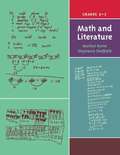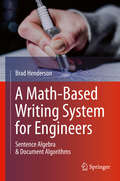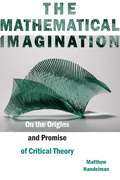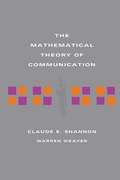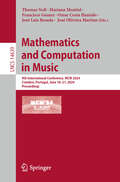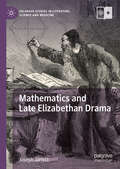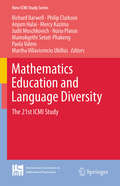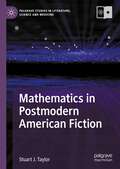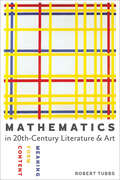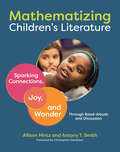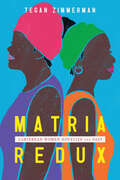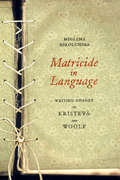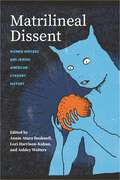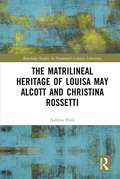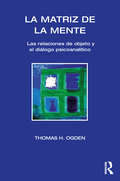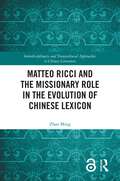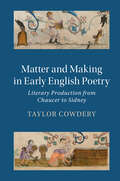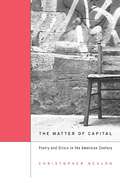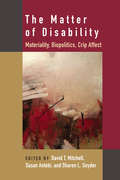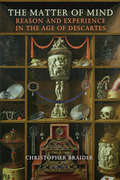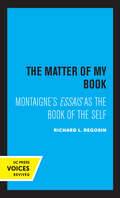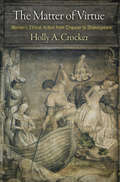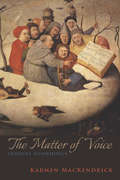- Table View
- List View
Math and Literature (Grades 2-3)
by Marilyn Burns Stephanie SheffieldFrom Quack and Count to Harry Potter, the imaginative ideas in children's books come to life in math lessons through this unique series. Each resource provides more than 20 classroom-tested lessons that engage children in mathematical problem solving and reasoning. Each lesson features an overview, materials required, and a vignette of how the lesson actually unfolded in a classroom. This book includes a reference chart indicating the mathematical concept each lesson covers, such as number, geometry, patterns, algebra, measurement, data analysis, or probability. Topics include counting, sorting, addition, subtraction, money, measurement, and patterns.
A Math-Based Writing System for Engineers: Sentence Algebra & Document Algorithms
by Brad HendersonThis book presents the generative rules for formal written communication, in an engineering context, through the lens of mathematics. Aimed at engineering students headed for careers in industry and professionals needing a “just in time” writing resource, this pragmatic text covers all that engineers need to become successful workplace writers, and leaves out all pedagogical piffle they do not. Organized into three levels of skill-specific instruction, A Math-Based Writing System for Engineers: Sentence Algebra & Document Algorithms guides readers through the process of building accurate, precise sentences to structuring efficient, effective reports. The book’s indexed design provides convenient access for both selective and comprehensive readers, and is ideal for university students; professionals seeking a thorough, “left -brained” treatment of English grammar and “go to” document structures; and ESL engineers at all levels.
The Mathematical Imagination: On the Origins and Promise of Critical Theory
by Matthew HandelmanThis book offers an archeology of the undeveloped potential of mathematics for critical theory. As Max Horkheimer and Theodor W. Adorno first conceived of the critical project in the 1930s, critical theory steadfastly opposed the mathematization of thought. Mathematics flattened thought into a dangerous positivism that led reason to the barbarism of World War II. The Mathematical Imagination challenges this narrative, showing how for other German-Jewish thinkers, such as Gershom Scholem, Franz Rosenzweig, and Siegfried Kracauer, mathematics offered metaphors to negotiate the crises of modernity during the Weimar Republic. Influential theories of poetry, messianism, and cultural critique, Handelman shows, borrowed from the philosophy of mathematics, infinitesimal calculus, and geometry in order to refashion cultural and aesthetic discourse.Drawn to the austerity and muteness of mathematics, these friends and forerunners of the Frankfurt School found in mathematical approaches to negativity strategies to capture the marginalized experiences and perspectives of Jews in Germany. Their vocabulary, in which theory could be both mathematical and critical, is missing from the intellectual history of critical theory, whether in the work of second generation critical theorists such as Jürgen Habermas or in contemporary critiques of technology. The Mathematical Imagination shows how Scholem, Rosenzweig, and Kracauer’s engagement with mathematics uncovers a more capacious vision of the critical project, one with tools that can help us intervene in our digital and increasingly mathematical present.
The Mathematical Theory of Communication
by Warren Weaver Claude E ShannonScientific knowledge grows at a phenomenal pace--but few books have had as lasting an impact or played as important a role in our modern world as The Mathematical Theory of Communication, published originally as a paper on communication theory more than fifty years ago. Republished in book form shortly thereafter, it has since gone through four hardcover and sixteen paperback printings. It is a revolutionary work, astounding in its foresight and contemporaneity. The University of Illinois Press is pleased and honored to issue this commemorative reprinting of a classic.
Mathematics and Computation in Music: 9th International Conference, MCM 2024, Coimbra, Portugal, June 18–21, 2024, Proceedings (Lecture Notes in Computer Science #14639)
by Thomas Noll Mariana Montiel Francisco Gómez Omar Costa Hamido José Luis Besada José Oliveira MartinsThis book constitutes the refereed proceedings of the 9th International Conference on Mathematics and Computation in Music, MCM 2024, held in Coimbra, Portugal, during June 18–21, 2024. The 30 full papers and 9 short papers included in this book were carefully reviewed and selected from 45 submissions. They were organized in topical sections as follows: mathematical scale theory and tuning; rhythm analysis and rhythm generation; categorical and algebraic approaches to music; quantum music; theory and algorithms for melodic- harmonic analysis and generation; geometric approaches to musical algorithms and microtonality; fourier analysis for music; similarity and distance measures for music; short papers; communication-performances; and tribute to Yves Hellegouarch.
Mathematics and Late Elizabethan Drama (Palgrave Studies in Literature, Science and Medicine)
by Joseph JarrettThis book considers the influence that sixteenth-century and early seventeenth-century mathematical thinking exerted on the writing and production of popular drama between about 1587 and 1603. It concentrates upon six plays by five early modern dramatists: Tamburlaine, Part 1 (1587) and Tamburlaine, Part 2 (1587) by Christopher Marlowe; Friar Bacon and Friar Bungay (1589) by Robert Greene; Old Fortunatus (1599) by Thomas Dekker; Hamlet (1600) by William Shakespeare; and The Tragedy of Hoffman (1603) by Henry Chettle. Each chapter analyses how the terms, concepts, and implications of contemporary mathematics impacted upon these plays’ vocabularies, forms, and aesthetic and dramaturgical effects and affects.
Mathematics Education and Language Diversity
by Richard Barwell Philip Clarkson Anjum Halai Mercy Kazima Judit Moschkovich Núria Planas Mamokgethi Setati-Phakeng Paola Valero Martha Villavicencio UbillúsThis book examines multiple facets of language diversity and mathematics education. It features renowned authors from around the world and explores the learning and teaching of mathematics in contexts that include multilingual classrooms, indigenous education, teacher education, blind and deaf learners, new media and tertiary education. Each chapter draws on research from two or more countries to illustrate important research findings, theoretical developments and practical strategies.
Mathematics in Postmodern American Fiction (Palgrave Studies in Literature, Science and Medicine)
by Stuart J. TaylorThis book delivers an innovative critical approach to better understand U.S. fiction of the information age, and argues that in the last eighty years, fiction has become increasingly concerned with its representations of mathematical ideas, images, and practices. In so doing, this book provides a fuller, transnational account of the place of mathematics in understanding mathematically informed novels. Literature and science studies have acknowledged and situated historical points of cultural crossover; by emphasising mathematics within this larger intellectual context – and not as an unlikely and alien adjunct to post-war culture – this monograph clarifies how mathematically informed postmodern fictions work in a cognate fashion to other fields undergoing structuralist revolutions. This is especially evident in fiction by the key, mathematically-literate Postmodern authors upon whom this study focuses, namely, Thomas Pynchon, Don DeLillo, and David Foster Wallace, through which recent the technological revolutions, facilitated by mathematics, manifest in cultural discourse.
Mathematics in Twentieth-Century Literature and Art: Content, Form, Meaning
by Robert TubbsChips away at the notion of an accidental relationship between math and art and literature.During the twentieth century, many artists and writers turned to abstract mathematical ideas to help them realize their aesthetic ambitions. Man Ray, Marcel Duchamp, and, perhaps most famously, Piet Mondrian used principles of mathematics in their work. Was it mere coincidence, or were these artists simply following their instincts, which in turn were ruled by mathematical underpinnings, such as optimal solutions for filling a space? If math exists within visual art, can it be found within literary pursuits? In short, just what is the relationship between mathematics and the creative arts?In this provocative, original exploration of mathematical ideas in art and literature, Robert Tubbs argues that the links are much stronger than previously imagined and exceed both coincidence and commonality of purpose. Not only does he argue that mathematical ideas guided the aesthetic visions of many twentieth-century artists and writers, Tubbs further asserts that artists and writers used math in their creative processes even though they seemed to have no affinity for mathematical thinking. In the end, Tubbs makes the case that art can be better appreciated when the math that inspired it is better understood. An insightful tour of the great masters of the last century and an argument that challenges long-held paradigms, Mathematics in Twentieth-Century Literature and Art will appeal to mathematicians, humanists, and artists, as well as instructors teaching the connections among math, literature, and art.
Mathematics in Twentieth-Century Literature & Art: Content, Form, Meaning
by Robert TubbsThe author of What Is a Number? examines the relationship between mathematics and art and literature of the 20th century.During the twentieth century, many artists and writers turned to abstract mathematical ideas to help them realize their aesthetic ambitions. Man Ray, Marcel Duchamp, and, perhaps most famously, Piet Mondrian used principles of mathematics in their work. Was it coincidence, or were these artists following their instincts, which were ruled by mathematical underpinnings, such as optimal solutions for filling a space? If math exists within visual art, can it be found within literary pursuits? In short, just what is the relationship between mathematics and the creative arts?In this exploration of mathematical ideas in art and literature, Robert Tubbs argues that the links are much stronger than previously imagined and exceed both coincidence and commonality of purpose. Not only does he argue that mathematical ideas guided the aesthetic visions of many twentieth-century artists and writers, Tubbs further asserts that artists and writers used math in their creative processes even though they seemed to have no affinity for mathematical thinking.In the end, Tubbs makes the case that art can be better appreciated when the math that inspired it is better understood. An insightful tour of the great masters of the last century and an argument that challenges long-held paradigms, this book will appeal to mathematicians, humanists, and artists, as well as instructors teaching the connections among math, literature, and art.“Though the content of Tubbs’s book is challenging, it is also accessible and should interest many on both sides of the perceived divide between mathematics and the arts.” —Choice
Mathematizing Children's Literature: Sparking Connections, Joy, and Wonder Through Read-Alouds and Discussion
by Allison Hintz Antony T. SmithMany teachers use traditional counting and shape books in math class. But what would happen if we approached any story with a math lens? How might mathematizing children's literature give learners space to ask their own questions, and make connections between stories, their lives, and the world around them? These are the questionsauthors Allison Hintz and Antony T. Smith set out to explore in Mathematizing Children's Literature: Sparking Connections, Joy, and Wonder Through Read-Alouds and Discussion as they invite us to consider fresh ways of using interactive read-alouds to nurture students as both readers and mathematicians.Inside Mathematizing Children's Literature , you'll learn how to do the following: Select picture books according to the goals of the read aloud experiencePlan and facilitate three styles of read aloud discussions - Open Notice and Wonder, Math Lens, and Story Explore UtilizeIdea Investigations - experiences that invite students to pursue literacy and math-focused ideas beyond the pages of the read aloudConnect withstudents' families and communities through storiesAlong the way, Hintz and Smith provide a wide range of picture book suggestions and appendices that include ready-to-use lesson planning templates, a form for notes, and a bookmark of guiding questions. Mathematizing Children's Literature is a practical resource you'll find yourself referring to frequently.
Matria Redux: Caribbean Women Novelize the Past (Caribbean Studies Series)
by Tegan ZimmermanIn Matria Redux: Caribbean Women Novelize the Past, author Tegan Zimmerman contends that there is a need for reading Caribbean women’s texts relationally. This comprehensive study argues that the writer’s turn to maternal histories constitutes the definitive feature of this transcultural and transnational genre. Through an array of Caribbean women’s historical novels published roughly between 1980 and 2010, this book formulates the theory of matria—an imagined maternal space and time—as a postcolonial-psychoanalytic feminist framework for reading fictions of maternal history written by and about Caribbean women. Tracing the development of the historical novel in four periods of the Caribbean past—slavery, colonialism, revolution, and decolonization—this study argues that a pan-Caribbean generation of women writers, of varying discursive racial(ized) realities, has depicted similar matria constructs and maternal motifs. A politicized concept, matria functions in the historical novel as a counternarrative to traditional historical and literary discourses. Through close readings of the mother/daughter plots in contemporary Caribbean women’s historical fiction, such as Andrea Levy’s The Long Song, Edwidge Danticat’s The Farming of Bones, Paule Marshall’s Praisesong for the Widow, and Marie-Elena John’s Unburnable, Matria Redux considers the concept of matria an important vehicle for postcolonial-psychoanalytic feminist literary resistance and political intervention. Matria as a psychoanalytic, postcolonial strategy therefore envisions, by returning to history, alternative feminist fictions, futures, and Caribbeans.
Matricide in Language: Writing Theory in Kristeva and Woolf
by Miglena NikolchinaThe nexus of psychoanalytic, literary, and philosophical approaches in this book focuses on an intertextual reading of Woolf and Kristeva in order to address the enigma of the persistent suppression of women's contributions to culture. In spite of the efforts of feminist theory and history to turn the tide, this process is with us still. "I am the first of a new genus" (Mary Wollstonecraft). "When I looked around, I saw and heard of none like me" (Mary Shelley). "I look everywhere for grandmothers and find none" (Elizabeth Barrett Browning). "Why isn't there a tradition of the mothers?" (Virginia Woolf). "Women have 'no past, no history'" (Simone de Beauvoir). "I look for myself throughout the centuries and I don't see myself anywhere" (Helene Cixous). As Woolf noted, "strange spaces of silence" separate the solitary female utterances throughout history. The brutal vicissitudes of the contemporary reception of feminist thinkers, crushed between traditional academia and an anti-intellectualism that describes itself as activism, are symptoms of the fact that the conditions, which produced the "strange spaces of silence" and made the repetitive generic loneliness from Wollstonecraft to Cixous possible, are still operative. They have found their way into the present age as "reactionary conformity that manages to discredit any notion of feminine specificity or freedom that is not based on seduction–which means not based on reproduction and consumption" (Kristeva).The intertextual approach to Kristeva and Woolf brings to light "matricide" as the silent engine behind the stammering of female temporality. "Matricide" is offered as an entrance to the conceptualization of the cultural ramifications of a language that wavers between hypnotic passion and murder. As Joan Scott has demonstrated, the oscillations between phantasies of uniqueness and phantasies of fusion are characteristic of women's movements. Matricide in Language claims that these fantasies are subtended by imaginary matricide and that they can explain the extreme discursive practices that are characteristic of the debate in and around feminism.
Matrilineal Dissent: Women Writers and Jewish American Literary History
by Jessica Kirzane Rachel Rubinstein Josh Lambert Tahneer Oksman Karen Skinazi Jennifer Glaser Alex UllmanBridging literary studies and cultural history, this edited volume examines Jewish women writers’ wide-ranging contributions to American literary culture from the turn of the twentieth century to the present. Matrilineal Dissent features innovative considerations of contemporary autofiction, graphic narratives, and novels by Mizrahi writers as well as middlebrow, Progressive Era, and second-wave feminist literature. Authors discussed herein—such as Roz Chast, Erica Jong,Annie Nathan Meyer, and Adrienne Rich—challenge monolithic representations of Jewishness and gender while imagining radical alternatives. By drawing attention to the politics of these authors and their readers, texts emerge as tools and living practices rather than as ends in themselves. Collectively, contributors reframe Jewish American literary history through feminist approaches that have revolutionized the field, from intersectionality and the #MeToo movement to queer theory and disability studies. Examining both canonical and lesser-known texts, this collection invites questions about conventional understandings of Jewish American literature when we center women’s writing and acknowledge women as dominant players in Jewish cultural production.
The Matrilineal Heritage of Louisa May Alcott and Christina Rossetti (Routledge Studies in Nineteenth Century Literature)
by Azelina FlintIn an unprecedented comparison of two of the most important female authors of the nineteenth century, Azelina Flint foregrounds the influence of the religious communities that shaped Louisa May Alcott’s and Christina Rossetti’s visions of female creativity. In the early stages of the authors’ careers, their artistic developments were associated with their patrilineal connections to two artistic movements that shaped the course of American and British history: the Transcendentalists and Pre-Raphaelites. Flint uncovers the authors’ rejections of the individualistic outlooks of these movements, demonstrating that Alcott and Rossetti affiliated themselves with their mothers and sisters’ religious faith. Applying the methodological framework of women’s mysticism, Flint reveals that Alcott’s and Rossetti’s religious beliefs were shaped by the devotional practices and life-writing texts of their matrilineal communities. Here, the authors’ iconic portrayals of female artists are examined in light of the examples of their mothers and sisters for the first time. Flint recovers a number of unpublished life-writings, including commonplace albums and juvenile newspapers, introducing readers to early versions of the authors’ iconic works. These recovered texts indicate that Alcott and Rossetti portrayed the female artist as a mouthpiece for a wider community of women committed to social justice and divine communion. By drawing attention to the parallels in the authors’ familial affiliations and religious beliefs, Flint recuperates a tradition of nineteenth-century women’s mysticism that departs from the individualistic models of male literary traditions to locate female empowerment in gynocentric relationships dedicated to achieving a shared revelation of God.
The Matrix Trilogy (SparkNotes Film Guide)
by SparkNotesThe Matrix Trilogy (SparkNotes Film Guide) Making the reading experience fun! SparkNotes Film Guides are one-stop guides to great works of film–masterpieces that are the foundations of filmmaking and film studies. Inside each guide you&’ll find thorough, insightful overviews of films from a variety of genres, styles, and time periods. Each film guide contains:Information about the director and the context in which the film was made Thoughtful analysis of major characters Details about themes, motifs, and symbols Explanations of the most important lines of dialogue In-depth discussions about what makes a film so remarkable SparkNotes Film Guides are an invaluable resource for students or anyone who wants to gain a deeper understanding of the great films they know and love.
La Matriz de la Mente: Las Relaciones de Objeto y Psicoanalitico
by Thomas H OgdenEstamos ante una visión global de la teoría de las relaciones de objeto desde una perspectiva kleiniana, que contiene capítulos sobre la fantasía, las posiciones esquizo-paranoide y depresiva, los objetos internos, y la obra de Winnicott sobre el espacio potencial.
Matteo Ricci and the Missionary Role in the Evolution of Chinese Lexicon (Interdisciplinary and Transcultural Approaches to Chinese Literature)
by Zhao MingThis is a systematic study of Matteo Ricci’s (1552–610) enormous impact on the development of modern scientific and intellectual terminology in China.Taking the Sino‑estern cultural exchanges initiated by Western Jesuit missionaries in the late‑ing dynasty as its starting point, this book comprehensively presents the new terms coined by Ricci (and his collaborators) in his religious, geographical, geometrical, and astronomical Chinese writings. It uses a multitude of examples adopted from Ricci’s Chinese works as well as from ancient Chinese documents to discuss etymological evolution. Ricci’s early coinages of terms and their subsequent history demonstrate the role of interaction and scholarly collaboration between the late Ming Jesuits and Chinese intellectuals in the formation of modern Chinese lexicon. The research conclusions of this book will further advance Ming‑ynasty studies and contribute to a new understanding of the creation of modern Chinese lexicon.This book is a vital resource for students, scholars, and linguists studying and researching in the history of Chinese and early Mandarin. This volume will also be very interesting among students and scholars of Chinese literature and history, particularly among scholars who work in Ming history and literature.The Open Access version of this book, available at www.taylorfrancis.com, has been made available under a Creative Commons Attribution-Non Commercial-No Derivatives (CC-BY-NC-ND) 4.0 International license
Matter and Making in Early English Poetry: Literary Production from Chaucer to Sidney (Cambridge Studies in Medieval Literature #121)
by Taylor CowderyWhat is literature made from? During the fourteenth, fifteenth, and sixteenth centuries, this question preoccupied the English court poets, who often claimed that their poems were not original creations, but adaptations of pre-existing materials. Their word for these materials was 'matter,' while the term they used to describe their labor was 'making,' or the act of reworking this matter into a new – but not entirely new – form. By tracing these ideas through the work of six major early poets, this book offers a revisionist literary history of late- medieval and early modern court poetry. It reconstructs premodern theories of making and contrasts them with more modern theories of literary labor, such as 'authorship.' It studies the textual, historical, and philosophical sources that the court tradition used for its matter. Most of all, it demonstrates that the early English court poets drew attention to their source materials as a literary tactic, one that stressed the process by which a poem had been made.
The Matter of Capital: Poetry and Crisis in the American Century
by Christopher S. NealonChristopher Nealon's reexamination of North America's poetry in English, from Ezra Pound and W. H. Auden to younger poets of the present day, argues persuasively that the central literary project of the past century was to explore the relationship between poetry and capitalism--its impact on individuals, communities, and cultures.
The Matter of Disability: Materiality, Biopolitics, Crip Affect (Corporealities: Discourses Of Disability)
by David T. Mitchell Susan Antebi Sharon L. SnyderThe Matter of Disability returns disability to its proper place as an ongoing historical process of corporeal, cognitive, and sensory mutation operating in a world of dynamic, even cataclysmic, change. The book’s contributors offer new theorizations of human and nonhuman embodiments and their complex evolutions in our global present, in essays that explore how disability might be imagined as participant in the “complex elaboration of difference,” rather than something gone awry in an otherwise stable process. This alternative approach to materiality sheds new light on the capacities that exist within the depictions of disability that the book examines, including Spider-Man, Of Mice and Men, and Bloodchild.
The Matter of Mind: Reason and Experience in the Age of Descartes
by Christopher BraiderWhat influence did Ren#65533; Descartes' concept of mind-body dualism have on early modern conceptions of the self? In The Matter of Mind, Christopher Braider challenges the presumed centrality of Descartes' groundbreaking theory to seventeenth-century French culture. He details the broad opposition to rational self-government among Descartes' contemporaries, and attributes conventional links between Descartes and the myth of the 'modern subject' to post-structuralist assessments. The Matter of Mind presents studies drawn from a range of disciplines and examines the paintings of Nicolas Poussin, the drama of Pierre Corneille, and the theology of Blaise Pascal. Braider argues that if early modern thought converged on a single model, then it was the experimental picture based on everyday experience proposed by Descartes' sceptical adversary, Michel de Montaigne. Forceful and provocative, The Matter of Mind will encourage lively debate on the norms and discourses of seventeenth-century philosophy.
The Matter of My Book: Montaigne's Essais as the Book of the Self
by Richard L. RegosinThis title is part of UC Press's Voices Revived program, which commemorates University of California Press’s mission to seek out and cultivate the brightest minds and give them voice, reach, and impact. Drawing on a backlist dating to 1893, Voices Revived makes high-quality, peer-reviewed scholarship accessible once again using print-on-demand technology. This title was originally published in 1977.
The Matter of Virtue: Women's Ethical Action from Chaucer to Shakespeare
by Holly A. CrockerIf material bodies have inherent, animating powers—or virtues, in the premodern sense—then those bodies typically and most insistently associated in the premodern period with matter—namely, women—cannot be inert and therefore incapable of ethical action, Holly Crocker contends. In The Matter of Virtue, Crocker argues that one idea of what it means to be human—a conception of humanity that includes vulnerability, endurance, and openness to others—emerges when we consider virtue in relation to modes of ethical action available to premodern women. While a misogynistic tradition of virtue ethics, from antiquity to the early modern period, largely cast a skeptical or dismissive eye on women, Crocker seeks to explore what happened when poets thought about the material body not as a tool of an empowered agent whose cultural supremacy was guaranteed by prevailing social structures but rather as something fragile and open, subject but also connected to others.After an introduction that analyzes Hamlet to establish a premodern tradition of material virtue, Part I investigates how retellings of the demise of the title female character in Chaucer's Troilus and Criseyde, Henryson's Testament of Cresseid, and Shakespeare's Troilus and Cressida among other texts structure a poetic debate over the potential for women's ethical action in a world dominated by masculine violence. Part II turns to narratives of female sanctity and feminine perfection, including ones by Chaucer, Bokenham, and Capgrave, to investigate grace, beauty, and intelligence as sources of women's ethical action. In Part III, Crocker examines a tension between women's virtues and household structures, paying particular attention to English Griselda- and shrew-literatures, including Shakespeare's Taming of the Shrew. She concludes by looking at Chaucer's Legend of Good Women to consider alternative forms of virtuous behavior for women as well as men.
The Matter of Voice: Sensual Soundings
by Karmen MacKendrickPhilosophers for millennia have tried to silence the physical musicality of voice in favor of the purity of ideas without matter, souls without bodies. Nevertheless, voices resonate among bodies, among texts, and across denotation and sound; they are singular, as unique as fingerprints, but irreducibly collective too. They are material, somatic, and musical. But voices are also meaningful—they give body to concepts that cannot exist in abstractions, essential to sense yet in excess of it. They can be neither reduced to neurology nor silenced in abstraction. They complicate the logos of the beginning and emphasize the enfleshing of all words. Through explorations of theology and philosophy, pedagogy, translation, and semiotics, all interwoven with song, The Matter of Voice works toward reintegrating our thinking about both speaking and authorial voice as fleshy combinings of meaning and music.
